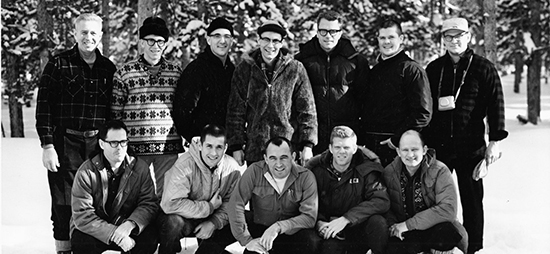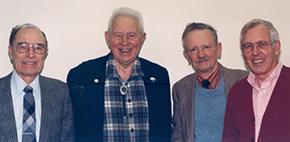Throwback Thursday: A Noble Head in the Clouds
 |
|
Schaefer's Boys: Vincent Schaefer, upper left, each year led young ASRC scientists to Yellowstone National Park to conduct field work. Left to right, top row: Larry Proctor, Dale Hartlief, August Aver, Griffith Morgen, John Stockner and Austin Hogan. Seated, left to right: Richard Layton, Charles Robertson, Thomas Henderson, John Hirsch, and Robert Smith Johnson. (Photo courtesy of University Archives) |
ALBANY, N.Y. (May 18, 2017) — One of the foremost research centers on weather in the world was begun by a man without a high school diploma.
Vincent Schaefer, a Schenectady native, had his only formal education through a correspondence course at the Davey Institute of Tree Surgery. Family financial woes had forced him to leave high school in 1922, and he journeyed from toolmaker at the G.E. Research Laboratory to a landscape gardener then back to G.E.’s machine shop.
All the while he built up a library on natural history, about which he created community adult education programs by 1933. He made the acquaintance of a devout conservationist at G.E. who introduced him to chemistry Nobel Laureate Irving Langmuir — like Schaefer a skier and lover of the outdoors. Langmuir took to the 26-year-old and moved him from the machine shop into research.
By 1940 Schaefer earned national publicity for his development of a method to make replicas of individual snowflakes using a thin plastic coating called Formvar. By 1943 he was working with Langmuir on precipitation static, aircraft icing, ice nuclei, and cloud physics.
 |
|
Old ASRC pros, from left Ray Falconer, Vincent Schaefer, Bernard Vonnegut and Duncan Blanchard, get together for a reunion in 1989. They worked together on Project Cirrus in the late 1940s, then all joined at ASRC in the early '60s. (Photo by Roger Cheng) |
Then, in 1946, came his major claim to fame: a laboratory method — begun in his home icebox — to seed super-cooled clouds with dry ice. Successful field tests of the seeding of natural clouds were eventually conducted by airplane. This led to his becoming laboratory coordinator of the U.S. military’s Project Cirrus, in which pilots carried out field tests and collected data for use at the G.E. labs.
Schaefer turned after the project’s conclusion in 1953 to private lab work, then to teaching through an American Meteorological Society and National Science Foundation-supported educational film show, “The Atmospheric Sciences Program.”
That work soon attracted the attention of New York State Teachers College science dean Oscar Lanford and President Evan Collins. Their successful invitation in 1960 to have Schaefer teach at the college ultimately led to his founding of the Atmospheric Sciences Research Center (ASRC) in 1961. He became director in 1966, a position he held for ten years before giving control to Volker Mohnen.
His legacy at ASRC is much due to his fame and past contacts that attracted extraordinarily qualified atmospheric science researchers to ASRC. Many he had met through his work at G.E. and other labs, and some, like Bernard Vonnegut, Raymond Falconer and Duncan Blanchard were veterans of Project Cirrus.
Schaefer retired from UAlbany in 1976. He died in Schenectady at 97 in 1993.
![]() For more news, subscribe to UAlbany's RSS headline feeds
For more news, subscribe to UAlbany's RSS headline feeds
A comprehensive public research university, the University at Albany-SUNY offers more than 120 undergraduate majors and minors and 125 master's, doctoral and graduate certificate programs. UAlbany is a leader among all New York State colleges and universities in such diverse fields as atmospheric and environmental sciences, business, education, public health,health sciences, criminal justice, emergency preparedness, engineering and applied sciences, informatics, public administration, social welfare and sociology, taught by an extensive roster of faculty experts. It also offers expanded academic and research opportunities for students through an affiliation with Albany Law School. With a curriculum enhanced by 600 study-abroad opportunities, UAlbany launches great careers.


